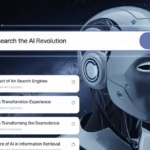Exploring Revolutionary AI Search Technology: The Future of Online Search


Estimated reading time: 10 minutes
Key Takeaways
Revolutionary AI Search Technology leverages NLP, ML, and neural networks to understand user intent beyond simple keywords, delivering more relevant and personalized results.
Search engines have evolved significantly from basic keyword matching (like AltaVista) to complex AI systems (like Google’s RankBrain and MUM) that grasp context and nuance.
AI personalizes web browsing by analyzing user data (history, location, device) to offer predictive suggestions, adaptive interfaces, and tailored content, significantly boosting engagement.
Voice Search AI uses advanced NLP to interpret spoken language, enabling hands-free interaction, multilingual communication, and improved accessibility.
AI algorithms utilize neural networks for pattern recognition and semantic analysis to understand the meaning behind queries, continuously refining results based on user feedback.
Benefits include hyper-relevant results and faster answers for users, and enhanced SEO optimization (boosting traffic) and precise ad targeting for businesses.
Challenges involve privacy concerns due to data collection, potential bias in AI algorithms, and the need for greater transparency in how search results are ranked.
Future trends point towards integration with AR, real-time multilingual capabilities, and sophisticated AI-generated summaries for complex topics.
Table of Contents
- 1. Introduction to Revolutionary AI Search Technology
- 2. The Evolution of Search Engines: From Basic Algorithms to AI-Powered Systems
- 3. How AI Personalizes Web Browsing
- 4. Voice Search AI: Bridging the Gap Between Speech and Digital Interaction
- 5. Behind the Scenes: How AI Search Engine Algorithms Work
- 6. Benefits of AI-Driven Search Technology for Users and Businesses
- 7. Challenges and Ethical Considerations
- 8. Future Trends in AI-Powered Search
- Frequently Asked Questions
1. Introduction to Revolutionary AI Search Technology
The landscape of online information retrieval is undergoing a seismic shift, driven by what we call revolutionary AI search technology. This isn’t just an upgrade; it’s a fundamental transformation of how we find, process, and interact with information on the internet. Forget the days of meticulously crafting keyword combinations. Modern AI-powered search engines (redefining how we seek information) are designed to understand you and the intent behind your queries.


At their core, these advanced systems harness the power of sophisticated technologies:
Natural Language Processing (NLP): This allows the engine to understand human language as it’s naturally spoken or written, including nuances, context, and even slang.
Machine Learning (ML): Search engines continuously learn from vast datasets of user interactions, refining their understanding of which results best satisfy specific types of queries.
Neural Networks: Inspired by the human brain, these complex networks identify intricate patterns and relationships within data, enabling deeper contextual understanding.
The result? Search results that are dynamic, context-aware, and incredibly precise. Instead of just matching keywords, the AI aims to grasp your underlying goal. For instance, searching “best budget laptops for students” using AI search doesn’t just spit back a list of pages containing those words. It analyzes your potential needs as a student (portability, battery life, software compatibility, price point) and considers factors like your location (for local deals), past search history (brand preferences perhaps?), and aggregated user reviews to suggest options truly tailored to your likely requirements. This shift towards understanding intent makes the search experience feel less like querying a database and more like having a conversation with a knowledgeable assistant.
The real-world impacts are significant. This improved efficiency streamlines tasks ranging from academic research and comparison shopping to complex problem-solving and simple navigation. Users experience faster decision-making as they spend less time sifting through irrelevant links and more time engaging with valuable information. Industry forecasts predict a dramatic increase in these interactions, suggesting that by 2025, over 50% of all search queries could involve some form of AI-driven interpretation. Pioneering technologies like Google’s Multitask Unified Model (MUM) and OpenAI’s powerful language models like GPT-4 are already demonstrating the potential, setting new benchmarks for accuracy, speed, and the ability to synthesise information from diverse sources (source: Penbrief).
2. The Evolution of Search Engines: From Basic Algorithms to AI-Powered Systems
The journey to today’s sophisticated AI-powered search engines has been a long and fascinating one, marked by incremental advancements and punctuated by revolutionary leaps. Understanding this evolution helps appreciate the profound capabilities of current systems.
Traditional Search Engine Algorithms
In the early days of the web, search engines like AltaVista, Lycos, and Infoseek operated on relatively simple principles. Their algorithms primarily focused on:
Keyword Density: How often a search term appeared on a page.
Meta Tags: Keywords explicitly listed by the website creator.
Backlinks: The number of other pages linking to a specific page (a rudimentary measure of authority, pioneered by Google’s PageRank).
While groundbreaking at the time, this approach had significant limitations. It was easily manipulated through “keyword stuffing” and often led to irrelevant results. Searching for “apple” might return pages about the fruit, the Beatles’ record label, or the tech giant, with little ability to discern the user’s actual intent based on context.
The Rise of AI in Search
The game changed with the gradual integration of artificial intelligence, particularly machine learning (SEO in the Age of AI). Google’s introduction of RankBrain in 2015 was a major milestone. RankBrain uses ML to interpret the meaning behind ambiguous or novel queries, going beyond simple keyword matching to understand semantic relationships.


Key advancements fueled by AI include:
Contextual Understanding: Modern AI systems (like Google’s AI) are adept at recognizing synonyms (e.g., understanding “cheap” means “budget” or “affordable”), related concepts, and the overall topic of a query. Typing “how to fix a leaky sink” now correctly prioritizes instructional content – step-by-step guides, video tutorials – over simply listing local plumbing services, because the AI understands the user’s intent is likely DIY repair.
Real-time Learning and Adaptation: AI algorithms constantly learn from user behavior. If users searching for a breaking news event consistently click on recent articles from reputable news sources, the AI learns to prioritize timeliness and authority for similar queries in the future. It adapts to trends, seasonality, and evolving language use.
Understanding Natural Language: Queries are becoming more conversational (like AI chatbots). People search using full sentences and questions (“what’s the best way to get from London to Paris?”). AI parses these natural language queries to extract the core intent.
These shifts have profoundly reduced the reliance on exact keyword matching, making the search process far more intuitive and effective. The engine works *with* the user, trying to understand their needs rather than just matching text strings.
3. How AI Personalizes Web Browsing
Beyond just improving search results, AI is increasingly used for AI personalized web browsing, tailoring the entire online experience to individual users. This goes far beyond simply remembering your login details; it involves dynamically adjusting content, recommendations, and even interfaces based on perceived user preferences and context.


The personalization engine relies on analyzing a variety of data points, often collected across sessions and platforms:
Browsing History: Pages visited, links clicked, time spent on site, search queries used.
Purchase History: Past transactions, items added to cart, wishlisted products (especially relevant for e-commerce).
Device Type and Settings: Differentiating between mobile vs. desktop usage, operating system, screen resolution, language preferences.
Geographic Location: Providing localized content, weather updates, store information, or culturally relevant recommendations.
Demographic Information: Age, gender, interests (often inferred or provided by the user).
Real-time Behavior: Mouse movements, scrolling patterns, interaction with specific page elements.
Mechanisms Behind Personalization
Machine learning algorithms (AI Personalization source) are the engines driving this personalization. They analyze these vast datasets to identify patterns and predict user needs or preferences. Common examples include:
Recommendation Engines: Spotify suggesting new artists based on your listening habits, Netflix recommending shows similar to ones you’ve watched, or Amazon showcasing products related to your past purchases and browsing behavior.
Personalized Content Feeds: Social media platforms curating posts based on your interactions, and news websites highlighting articles relevant to topics you frequently read.
Dynamic Website Content: Websites adjusting hero banners, promotional offers, or even call-to-action buttons based on user segments (e.g., showing different deals to new vs. returning visitors).
User Benefits
When implemented effectively, AI personalization offers tangible benefits to users:
Increased Relevance: Content and recommendations feel more aligned with individual interests, reducing noise and information overload.
Time Savings: Predictive search suggestions (autocomplete) speed up queries, while personalized interfaces streamline navigation.
Discovery: AI can introduce users to new products, music, articles, or services they might not have found otherwise.
Adaptive Interfaces: Websites automatically adjust layouts for optimal viewing and interaction on different devices, particularly smartphones (like smart home devices integration).
The impact on business metrics is also notable. For example, a study cited by 10Web indicated that personalized recommendations can boost e-commerce conversion rates by as much as 35%, highlighting the commercial power of tailoring the user experience (source: 10web.io). However, this reliance on data also raises significant privacy considerations, discussed later.
4. Voice Search AI: Bridging the Gap Between Speech and Digital Interaction
One of the most intuitive evolutions in search is the rise of voice search AI. Enabled by assistants like Google Assistant, Amazon Alexa, and Apple’s Siri, voice search allows users to interact with search engines and digital devices simply by speaking naturally, rather than typing queries into a search bar.


How It Works: The Power of NLP
At the heart of voice search lies sophisticated Natural Language Processing (NLP). The process typically involves several stages:
Automatic Speech Recognition (ASR): Converting the spoken audio waves into machine-readable text.
Natural Language Understanding (NLU): Analyzing the transcribed text to decipher the user’s intent, grammar, entities (like names, locations, dates), and context. This is where the AI grapples with accents, slang, background noise, and ambiguous phrasing.
Query Processing: Formulating a search query based on the understood intent.
Information Retrieval/Action Execution: Fetching the relevant information from the web or executing a command (e.g., setting a timer, playing music).
Text-to-Speech (TTS): Synthesizing a spoken response to deliver the answer back to the user naturally.
The complexity lies in NLU. Asking something conversational like, “What’s the vibe in NYC right now?” requires the AI (source: newo.ai) to infer that “vibe” might relate to current events, social media trends, weather, or perhaps even traffic conditions, and then synthesize a relevant summary.
Expanding Use Cases
Voice search is moving beyond simple fact-finding queries:
Hands-Free Operation: Essential while driving (navigation, calls), cooking (timers, recipe steps), or multitasking.
Smart Home Control: Managing lights, thermostats, security systems, and entertainment via voice commands.
Accessibility: Providing a crucial interface for users with visual impairments or motor disabilities to navigate applications and access information.
Multilingual Searches and Translation: Asking a question in one language and receiving an answer in another, or requesting real-time translation. For example, asking “Where’s the nearest pharmacy?” while traveling could trigger a response translated into Spanish.
Local Search: Finding nearby businesses (“find coffee shops near me open now”).
The accuracy of these systems has improved dramatically. For example, Google Assistant reportedly answers around 93% of queries accurately (source: ctidigital.com), a significant jump from previous years, demonstrating the rapid advancement in NLP and AI understanding.
5. Behind the Scenes: How AI Search Engine Algorithms Work
While the user experience of AI search feels increasingly seamless, the underlying search engine algorithms are incredibly complex systems operating at a massive scale. Two core components are central to their function: neural networks and semantic analysis, coupled with a continuous learning process.
Neural Networks: The Pattern Finders
Inspired by the interconnected neurons in the human brain, artificial neural networks are computational models designed to recognize patterns in data. In the context of search, these networks process billions of data points – web pages, user queries, click behavior, links between sites – to identify subtle relationships and hierarchies.


For example, a neural network can learn that the word “Python” likely refers to the programming language when encountered on websites like Stack Overflow or GitHub, but probably refers to the snake when found on biology forums or zoo websites. This ability to disambiguate words based on surrounding context (semantic context) is crucial for understanding user intent accurately. They help determine page relevance, authority, and trustworthiness based on complex signals far beyond simple keyword counts.
Semantic Analysis: Understanding Meaning
Semantic analysis focuses on deciphering the meaning and intent behind the words used in a query, rather than just their literal form. AI employs techniques like:
Entity Recognition: Identifying key entities like people, places, organizations, and concepts within a query.
Relationship Extraction: Understanding how entities relate to each other (e.g., “CEO of Apple” links Tim Cook to Apple).
Sentiment Analysis: Determining the emotional tone (positive, negative, neutral) which can influence results, especially for reviews or opinions.
Contextual Disambiguation: Distinguishing between multiple meanings of a word based on context (e.g., “hot” meaning high temperature versus “hot” meaning popular or trending).


This deeper level of understanding allows AI search engines (source: ctidigital.com) to handle complex, conversational, or even poorly phrased queries more effectively, matching them to relevant content even if the exact keywords aren’t present.
Continuous Learning and Feedback Loops
Unlike static algorithms of the past, AI search engines are dynamic and constantly learning. They incorporate feedback loops based on user interactions:
Click-Through Rate (CTR): Which results do users actually click on?
Dwell Time: How long do users stay on a page after clicking?
Bounce Rate: Do users immediately return to the search results (suggesting dissatisfaction)?
Query Refinement: Do users modify their search terms after viewing initial results?
If a particular result is consistently skipped over or leads to quick bounces, the AI learns that it might be less relevant for that query or intent and adjusts its ranking accordingly. This continuous refinement process helps the algorithms adapt to changing user expectations and the evolving nature of online content.
6. Benefits of AI-Driven Search Technology for Users and Businesses
The integration of AI into search engines offers a compelling suite of advantages, creating a win-win scenario for both individual users seeking information and businesses aiming to connect with their target audiences. This revolutionary AI search technology (Embracing the AI Search Revolution) is fundamentally improving the efficiency and effectiveness of online interactions.
Advantages for Users
End-users experience the benefits most directly through an enhanced search experience:
Hyper-Relevant Results: AI’s ability to understand intent delivers answers that are precisely tailored to the user’s needs. Searching for “gluten-free restaurants near me with outdoor seating” yields results that match all those criteria, not just pages mentioning “restaurants.” This saves significant time and effort.
Faster Answers and Summarization: AI can often synthesize information from multiple sources to provide direct answers or concise summaries directly on the search results page (like Google’s Featured Snippets or AI Overviews). This eliminates the need to click through multiple links for quick facts or definitions.
Conversational Interaction: Voice search and improved NLP allow users to phrase queries naturally, making search more accessible and intuitive.
Discovery of Related Content: AI can surface related topics or questions the user might not have thought to ask, facilitating deeper exploration and learning.
Personalized Experience: Tailored results based on history, location, and preferences make the search process feel more efficient and relevant to the individual.
Advantages for Businesses
Businesses also stand to gain significantly from the AI search revolution:
Enhanced SEO Optimization: AI provides deeper insights into user intent and semantic search trends. Businesses can leverage AI tools to identify high-impact keywords, understand topic clusters relevant to their audience, and optimize content to directly answer user questions, leading to better organic rankings.
More Effective Ad Targeting: AI algorithms analyze user behavior, search history, and contextual signals with greater precision. This allows businesses to target their advertising campaigns more effectively, reaching users who are genuinely interested in their products or services at the right moment, improving ROI.
Improved Customer Understanding: Analyzing AI-driven search trends provides valuable insights into customer needs, pain points, and emerging interests, informing product development, content strategy, and marketing messages.
Competitive Advantage: Businesses that adapt their content and digital strategies to align with how AI search engines rank information are better positioned to attract organic traffic and leads.


The tangible impact is clear: one study highlighted by madg.com found that AI-driven SEO strategies could boost organic traffic by up to 40%, demonstrating the powerful potential for businesses willing to embrace these changes.
7. Challenges and Ethical Considerations
Despite the numerous benefits, the increasing sophistication and pervasiveness of AI search engine algorithms also present significant challenges and ethical dilemmas that require careful consideration and proactive solutions.
Privacy Risks and Data Collection
Effective personalization relies heavily on collecting and analyzing vast amounts of user data – search history, location, browsing habits, clicks, and potentially more (The Revolution of AI-Powered Search Engines). This raises critical privacy concerns:
Data Security: Storing massive user datasets creates attractive targets for data breaches.
User Consent and Control: Are users fully aware of what data is being collected and how it’s being used? Do they have meaningful control over their data?
Potential for Misuse: Aggregated user data, even if anonymized, could potentially be used for surveillance or manipulation.
Regulatory frameworks like GDPR in Europe and CCPA in California attempt to address these issues by mandating stricter consent requirements and data protection practices, but compliance remains a complex challenge.
Bias in AI Algorithms
AI systems learn from the data they are trained on. If that data reflects existing societal biases, the AI will likely perpetuate and even amplify them. In search, this can manifest as:
Skewed Representation: Search results might disproportionately favor certain demographics, viewpoints, or sources. For example, a 2023 audit suggested some algorithms inadvertently prioritized content from English-speaking Western countries, potentially marginalizing valuable information from other regions or in different languages.
Reinforcement of Stereotypes: Image search results or autocomplete suggestions might reflect harmful stereotypes present in the training data.
Filter Bubbles and Echo Chambers: Over-personalization can lead to users primarily seeing content that confirms their existing beliefs, limiting exposure to diverse perspectives.
Addressing AI bias requires careful dataset curation, algorithmic audits, and ongoing monitoring to ensure fairness and equity in information access (source: ctidigital.com).
Transparency and Explainability
Many advanced AI models, particularly deep neural networks, function as “black boxes.” It can be difficult even for developers to understand precisely *why* a specific result was ranked higher than another. This lack of transparency raises concerns:
Accountability: If results are biased or inaccurate, it’s hard to pinpoint the cause and rectify it.
User Trust: Users increasingly demand clarity on how information influencing their decisions (e.g., product recommendations, news) is curated and ranked.
Manipulation Concerns: Opaque algorithms could potentially be manipulated for commercial or political gain without easy detection.
The field of Explainable AI (XAI) is actively working on developing methods to make AI decision-making processes more understandable, but achieving full transparency in complex search algorithms remains a major hurdle.
Spread of Misinformation
While AI aims for relevance, it can struggle to consistently evaluate the factual accuracy or quality of information at scale. This vulnerability can be exploited to spread misinformation or low-quality content, especially if it’s optimized to mimic signals of authority or engagement that the AI prioritizes.
8. Future Trends in AI-Powered Search
The evolution of AI-powered search engines is far from over. We are on the cusp of even more integrated, intuitive, and powerful search experiences, driven by the convergence of AI with other emerging technologies (AI Search Revolution continues).


Integration with Augmented Reality (AR)
Imagine pointing your smartphone camera at a historical landmark and instantly seeing relevant information – its history, architectural details, visitor reviews – overlaid directly onto your screen. AR search could revolutionize navigation (visual directions overlaid on the street), shopping (visualizing furniture in your room before buying), and education by seamlessly blending digital information with the physical world.
Real-Time Multilingual Search and Translation
While basic translation exists, future AI search aims for seamless, real-time cross-lingual communication. You could ask a complex question in English and receive a comprehensive answer synthesized from sources originally written in Mandarin, German, or Hindi, fully translated and presented instantly (powered by edge computing). This could break down language barriers in research, international business, and global communication.
Sophisticated AI-Generated Summaries and Synthesis
Current AI summaries are often limited to extracting key sentences. Future iterations aim to provide much more sophisticated, coherent, and context-aware syntheses of information drawn from multiple complex sources. Imagine asking, “Explain the implications of quantum computing for cybersecurity,” and receiving a concise, accurate breakdown generated by AI, complete with citations, without needing to read multiple dense articles (dentsu.com insights).
Hyper-Contextual Predictive Search
AI will likely become even better at anticipating your needs before you explicitly search. By integrating signals from your calendar, email, location, time of day, and broader behavioral patterns, search engines might proactively surface relevant information – like traffic alerts before your commute, restaurant recommendations near your next meeting location, or research papers related to an upcoming project deadline.
Multimodal Search (Beyond Text and Voice)
Search will increasingly integrate different types of input. Combining an image with a text query (“Where can I buy a chair that looks like this but in blue?”) or using voice to refine a visual search will become more common, allowing for more nuanced and specific information retrieval.
These advancements promise an even more powerful and integrated role for AI search in our daily lives, blurring the lines between seeking information and interacting with the digital world.
Frequently Asked Questions
1. How is AI search different from traditional keyword search?
Traditional search primarily matches the keywords in your query to keywords on web pages. AI search goes further by using Natural Language Processing (NLP) and Machine Learning (ML) to understand the intent and context behind your query. It can grasp synonyms, related concepts, and conversational language to provide more relevant results, even if the exact keywords aren’t present on the page. It also enables features like personalization, voice search, and direct answers/summaries.
2. Will AI search make traditional SEO obsolete?
No, but it significantly evolves SEO. While exact keyword matching becomes less critical, understanding user intent, creating high-quality content that answers specific questions thoroughly (semantic SEO), ensuring technical site health, and building authority remain crucial. AI actually provides new tools for SEO professionals (see madg.com) to better understand search trends and optimize content for how AI algorithms interpret relevance and value.
3. How can I protect my privacy while using AI-powered search and personalized features?
You can take several steps: Regularly review and adjust the privacy settings of your search engine and browser, limiting data collection like location history and web activity where possible. Consider using privacy-focused browsers or search engines (like DuckDuckGo). Be mindful of the permissions you grant to websites and apps. You can also clear your search history periodically and use incognito or private browsing modes for sensitive searches, although these offer limited protection against tracking by the search provider itself.
4. What is the difference between AI search engines and AI chatbots like ChatGPT?
While both use AI and NLP, their primary functions differ. AI search engines are designed to index the vast web and retrieve existing information (web pages, images, videos) relevant to a query. AI chatbots (like those used in customer service or standalone models like ChatGPT) are primarily designed to generate human-like text responses based on the input they receive and their training data. Search engines find existing answers; chatbots often create new answers. However, the lines are blurring as search engines integrate generative AI features (like AI Overviews) and some chatbots incorporate web search capabilities.
5. Can AI search results be biased or inaccurate?
Yes. AI algorithms learn from data, and if that data contains biases, the AI can replicate and even amplify them (as highlighted by Dentsu). This can lead to skewed results favoring certain viewpoints or demographics. Furthermore, AI prioritizes relevance based on complex signals but doesn’t always guarantee factual accuracy, especially with rapidly evolving topics or the spread of misinformation. Critical thinking and cross-referencing information remain essential when using any search engine.






